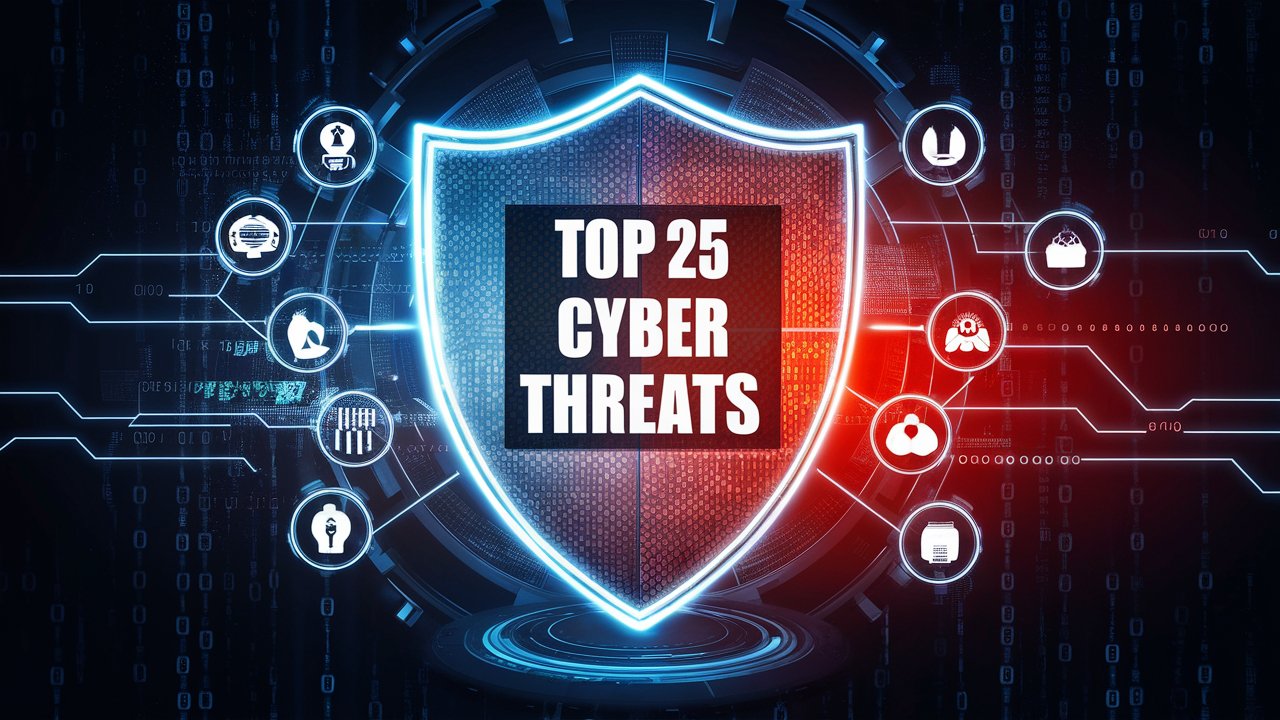
Top 25 Cyber Threats: Introduction & Solutions
Cyber Threats: Introduction & Solutions
- Credential Phishing Credential phishing is a cyber attack where attackers impersonate legitimate entities to trick individuals into revealing sensitive information, such as usernames, passwords, or financial data.
Solution:
- Implement email filtering and anti-phishing technologies to detect and block phishing emails before they reach users.
- Enable multi-factor authentication (MFA) for sensitive accounts to enhance security, even if credentials are compromised.
- DNS Tunneling DNS tunneling is a technique used by attackers to bypass security controls by encapsulating data within DNS queries, allowing covert data exfiltration or communication with command-and-control servers.
Solution:
- Monitor DNS traffic for anomalies like high query rates and unexpected payloads.
- Use DNS security solutions, such as DNS firewalls and threat intelligence feeds, to block malicious traffic.
- Cross-Site Request Forgery (CSRF) CSRF attacks exploit the trust between a user’s browser and a web application to execute unauthorized actions.
Solution:
- Implement anti-CSRF tokens to validate request authenticity.
- Utilize SOP and CORS headers to restrict cross-origin requests and prevent unauthorized access.
- Data Manipulation Attacks These attacks involve unauthorized alterations to data stored in databases or applications, compromising data integrity.
Solution:
- Implement cryptographic hashing and digital signatures for data integrity verification.
- Enforce role-based access controls and maintain audit logs for traceability.
- IoT Firmware Vulnerabilities Security flaws in IoT firmware can be exploited to compromise devices.
Solution:
- Conduct code reviews, static analysis, and vulnerability assessments.
- Implement secure boot mechanisms and signed firmware updates.
- Side-Channel Attacks These attacks exploit unintended information leakage to extract sensitive data.
Solution:
- Use constant-time algorithms and cryptographic blinding.
- Employ hardware-based security mechanisms like TEEs and HSMs.
- SIM Swapping Attackers fraudulently transfer a victim’s phone number to a new SIM card, intercepting calls, messages, and authentication codes.
Solution:
- Require biometric verification, security questions, or PIN codes for SIM swaps.
- Ransomware Ransomware encrypts files or locks systems, demanding payment for access restoration.
Solution:
- Regularly update software and patch vulnerabilities.
- Maintain robust backup systems and educate employees about phishing tactics.
- Phishing Attacks Fraudulent attempts to obtain sensitive information by posing as a trustworthy entity.
Solution:
- Use email filters and train employees to recognize phishing tactics.
- Implement MFA for added security.
- Distributed Denial-of-Service (DDoS) Attacks DDoS attacks overwhelm a target with traffic, causing disruptions.
Solution:
- Deploy DDoS mitigation services.
- Configure network infrastructure for traffic spikes and implement rate limiting.
- Insider Threats Malicious or negligent actions by individuals within an organization.
Solution:
- Apply least privilege principles and monitor user activity.
- Conduct regular security awareness training.
- Zero-Day Exploits These exploits target unknown software vulnerabilities before patches are available.
Solution:
- Use intrusion detection systems and virtual patching solutions.
- Encourage responsible disclosure of vulnerabilities.
- Data Breaches Unauthorized access to sensitive data, exposing personal or corporate information.
Solution:
- Encrypt data at rest and in transit.
- Implement strict access controls and continuous monitoring.
- Malware Malicious software designed to damage or gain unauthorized access to systems.
Solution:
- Use antivirus and anti-malware solutions.
- Keep software updated and practice safe browsing habits.
- Advanced Persistent Threats (APTs) Long-term, sophisticated attacks to infiltrate and maintain unauthorized network access.
Solution:
- Use network segmentation, encryption, and intrusion detection systems.
- Conduct security assessments and penetration testing.
- Supply Chain Attacks Exploiting vulnerabilities in third-party software or services.
Solution:
- Vet and monitor third-party vendors.
- Use software composition analysis tools to detect vulnerabilities.
- Cryptojacking Unauthorized use of computing resources to mine cryptocurrency.
Solution:
- Deploy endpoint security solutions and browser script blockers.
- Monitor system resources for abnormal CPU spikes.
- Man-in-the-Middle (MitM) Attacks Intercepting communication between two parties to eavesdrop or manipulate data.
Solution:
- Use HTTPS and encryption protocols.
- Implement digital certificates and update network devices regularly.
- Social Engineering Attacks Exploiting human psychology to manipulate individuals into revealing sensitive information.
Solution:
- Provide security awareness training.
- Enforce strict verification procedures for sensitive requests.
- Clickjacking Tricking users into clicking hidden elements, leading to unintended actions.
Solution:
- Implement X-Frame-Options and Content Security Policy (CSP) headers.
- Educate users about suspicious links.
- Botnet Attacks Large-scale attacks using compromised devices controlled remotely.
Solution:
- Monitor network traffic for anomalies.
- Use anti-bot software and restrict suspicious IPs.
- Rogue Software Deceptive software that misleads users into downloading malicious applications.
Solution:
- Encourage downloading software only from trusted sources.
- Use endpoint protection solutions.
- Drive-by Downloads Malicious software installed without user consent through compromised websites.
Solution:
- Keep web browsers updated and use security extensions.
- Block suspicious scripts and ads.
- Credential Stuffing Using leaked username-password combinations to gain unauthorized access.
Solution:
- Enforce password policies and implement rate limiting.
- Use MFA and monitor login attempts for anomalies.
- Cloud Security Threats Misconfigurations and vulnerabilities in cloud environments.
Solution:
- Implement robust IAM policies and encrypt cloud-stored data.
- Regularly audit and monitor cloud configurations for security gaps.
“Tip”
For personalized cybersecurity guidance, book a consultation call with our experts. Contact us now to stay one step ahead of cybercriminals.